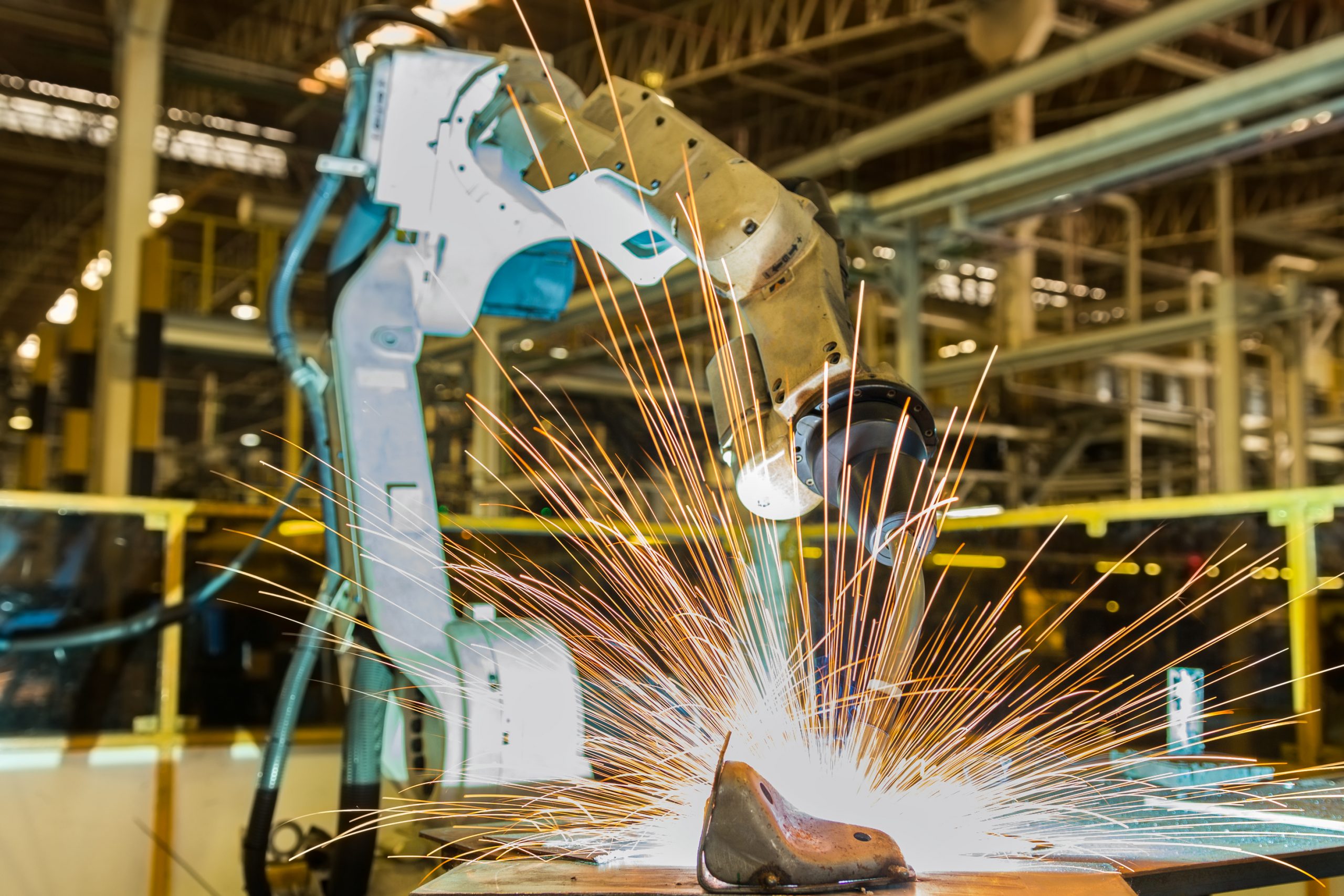Industrial fabrication—often called industrial metal fabrication—is the practice of shaping metal from raw materials into dependable metal parts, metal products, and metal structures that work in real plant conditions. Think platforms, guarding, hoppers, frames, brackets, and precision components built to fit your space, your process, and your uptime windows.
Industrial fabrication turns metallic materials (sheet and structural steel, stainless steel, aluminum) into plant-ready assets. A GC-led plan covers design assist, cutting/forming/robotic welding/powder coating, and installation—all coordinated around production. Clear RFQs and early site walks tighten schedules and reduce change orders.
How the metal fabrication process works (from idea to install)
A solid metal fabrication process moves scope → materials → cutting → forming → welding/assembly → finish → installation, with QA at each step. Typical flows use processes including laser cutting for accurate profiles, press-brake forming for geometry, fit-up and robotic welding for consistent joints, then surface prep with powder coating or stainless passivation for durability.
Installation is part of the package—rigging, anchoring, tie-ins, and restart are planned around shifts and outages with LOTO (lockout/tagout) and permit steps—so the finished assembly ties cleanly into existing manufacturing processes.
Which materials should you choose? (carbon steel, stainless steel, aluminum)
Match metallic materials to environment, strength, cleanability, and lifecycle cost.
- Carbon steel: great value and stiffness for general duty.
- Stainless steel (304/316): best for wash-down, food contact, or corrosive areas.
- Aluminum: lighter weight where manual handling or lift limits matter.
Also consider abrasion, chemicals, thermal expansion, and finish compatibility so the asset lasts in your conditions.
Sheet metal vs. structural steel (when to use each)
Use sheet metal for formed geometry, lighter weight, and frequent access (guards, hoods, drip pans). Use structural steel when span and load control the design (columns, beams, mezzanines, stair towers, platforms). Most real solutions blend both to balance stiffness, weight, and maintenance access—e.g., formed toe-kicks and covers on structural stringers and columns. See also: platforms & catwalks.
Where fabrication pays off on the plant floor
You’ll see the benefits anywhere safety, ergonomics, or flow constrain output:
- Material handling: racks, carts, fork pockets, lift points sized to loads and aisles. (material handling)
- Access & guarding: platforms, catwalks, rails, and machine guarding that protect without blocking service.
- Flow & containment: hoppers, chutes, diverters, bins, drip pans to reduce spills and cross-contamination.
- Integration: frames, skids, sensor mounts, and precision machine parts (often written on RFQs as “machines parts”) that adapt OEM equipment to your footprint.
- Overhead movement: crane runways, monorails, and tie-in steel aligned to clearances and fall-protection requirements.
These solutions support a wide range of operational goals: safer access, cleaner lines, faster changeovers, and better ergonomics.
What Is Industrial Fabrication? Industries and What Changes by Environment
Sector rules shape the spec.
- Food & beverage: stainless, passivation, crevice-free design, tool-less access for sanitation.
- Pharma: traceability, documented cleanability, validated finishes.
- Automotive: robust fixtures/guarding for cycle-time repeatability.
- Consumer goods & distribution: durability, visibility, and quick changeovers.
Materials, finishes, documentation, and installation sequencing should align with the audits and operating standards in your industry.
Quality and safety
Quality is procedural, not accidental. Expect qualified weld procedures (WPS/PQR), dimensional checks before and after assembly, and finishes matched to duty (e.g., blast profile and film thickness for powder coating, passivation for stainless steel).
Acceptance checklist (“done-done”):
- Level and anchored
- Clearances verified
- Finish to spec (powder-coat film thickness / passivation certificate)
- Edges deburred
- Safety dimensions confirmed (guarding heights, toe-kicks, ladder cages, pinch-point clearances)
- Documentation delivered (as-builts, anchor layouts, torque specs, care/maintenance)
- Aligned with site standards and relevant codes where applicable (e.g., OSHA / IBC / ASME)
How to start a fabrication project (simple, low-friction path)
- Walk-through → A quick site visit (or video call with photos) shows the space, constraints, and success metrics—what it must do, where it fits, when it needs to be live.
- Plan → You get basic drawings/sketches, recommended materials, a rough budget, and a timeline that phases work between shifts or short outages.
- Build & install → Cutting, forming, welding, finishing and installation are coordinated under one plan. Install lands in low-impact windows, and turnover gives maintenance what they need on day one.
What Is Industrial Fabrication: What to include in your RFQ (so you get a faster, tighter bid)
 Clear inputs beat guesswork and reduce change orders. Include:
Clear inputs beat guesswork and reduce change orders. Include:
- Goal & location (safety/throughput/sanitation + “access platform at Tank 4”).
- Photos or a quick sketch—or PDF/DWG/STEP with rough dimensions—plus nearby obstacles.
- Material/finish preference (e.g., 304/316 stainless steel with passivation, or carbon steel with powder coating).
- Loads & use (people/product weight, vibration, heat, impact).
- Surroundings (aisle widths, forklifts, utilities, cleaning chemicals, PM clearances).
- Install windows (nights/weekends/holiday outages; blackout dates).
- Turnover expectations (as-builts, maintenance notes, coating thickness report, passivation cert).
The better the inputs, the tighter the schedule and price—and the easier it is to value-engineer without risking performance.
Why a GC-led approach saves time and cost (and what drives schedule/price)
Fabrication touches multiple disciplines; a general contractor (GC) keeps safety, scope, schedule, and communication on one plan—so cutting, forming, welding, coatings, electrical/controls, and sometimes concrete/fall protection move in sync. That means fewer change orders, shorter outages, and predictable cost when every hour of downtime matters.
What really drives timeline and budget: drawings/approvals, material markets, thickness/tolerance, finish choices, and field access constraints. De-risk with early site walks, quick design assist, modular sub-assemblies that install fast, and smart alternates in metallic materials and standard hardware.
Lead times, acceptance, and “done-done”
Most lead time sits in approvals and finishing. Keep reviews moving, lock finishes early, and plan installation windows that match production. Acceptance is simple when criteria are defined up front (see the checklist above).
What Is Industrial Fabrication FAQs
What’s the difference between fabrication and machining?
Fabrication forms and joins stock shapes—plate, tube, sheet metal, structural steel—into assemblies. Machining removes material for precision features. Many projects use both.
Can stainless solutions support wash-down sanitation?
Yes. Stainless steel with polished seams, sanitary fasteners, and post-fabrication passivation supports cleanability and corrosion resistance.
Do coatings and color standards matter?
They do. Specify powder coating with documented prep and film thickness; consistent colors improve visibility and maintenance across the facility.
How do teams limit downtime during install?
Prefabricate and kit assemblies, define LOTO and permits early, schedule night/weekend work, and agree on restart criteria in advance.
Can one contractor coordinate everything and handle installation?
Yes—a GC can coordinate specialist fabricators, coatings, rigging, and electrical/controls and perform the installation under one schedule and safety program so assets integrate with existing manufacturing processes. See: equipment installations and custom metal fabrication.
Ready to turn ideas into durable, plant-ready results?
If you need a platform, guard, chute, frame, or precision component—and you want it fabricated and installed without disrupting production—Storee Construction can lead as your industrial general contractor, bringing the right specialists together and handling installation under one plan. With more than 50 years serving industrial clients (since 1966), we know how to build around uptime.
Start your project today Request a site walk or send an RFQ via the Industrial Fabrication page, and you’ll get options, pricing, and a phased plan that protects safety, budget, and schedule.
View the original article and our Inspiration here


Leave a Reply